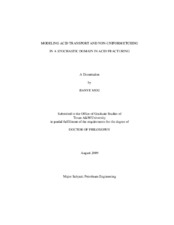| dc.description.abstract | Success of acid fracturing depends on uneven etching along the fracture surfaces
caused by heterogeneities such as variations in local mineralogy and variations in leakoff
behavior. The heterogeneities tend to create channeling characteristics, which provide
lasting conductivity after fracture closure, and occur on a scale that is neither used in
laboratory measurements of acid fracture conductivity, which use core samples that are
too small to observe such a feature, nor in typical acid fracture simulations in which the
grid block size is much larger than the scale of local heterogeneities. Acid fracture
conductivity depends on fracture surface etching patterns. Existing acid fracture
conductivity correlations are for random asperity distributions and do not consider the
contribution of channels to the conductivity. An acid fracture conductivity correlation
needs the average fracture width at zero closure stress. Existing correlations calculate
average fracture width using dissolved rock equivalent width without considering the
effect of reservoir characteristics. The purpose of this work is to develop an intermediate-scale acid fracture model
with grid size small enough and the whole dimension big enough to capture local and
macro heterogeneity effects and channeling characteristics in acid fracturing. The model
predicts pressure field, flow field, acid concentration profiles, and fracture surface
profiles as a function of acid contact time. By extensive numerical experiments with the
model, we develop correlations of fracture conductivity and average fracture width at
zero closure stress as a function of statistical parameters of permeability and mineralogy
distributions.
With the model, we analyzed the relationships among fracture surface etching
patterns, conductivities, and the distributions of permeability and mineralogy. From
result analysis, we found that a fracture with channels extending from the inlet to the
outlet of the fracture has a high conductivity because fluid flow in deep channels needs a
very small pressure drop. Such long and highly conductive channels can be created by
acids if the formation has heterogeneities in either permeability or mineralogy, or both,
with high correlation length in the direction of the fracture, which is the case in
laminated formations. | en |


